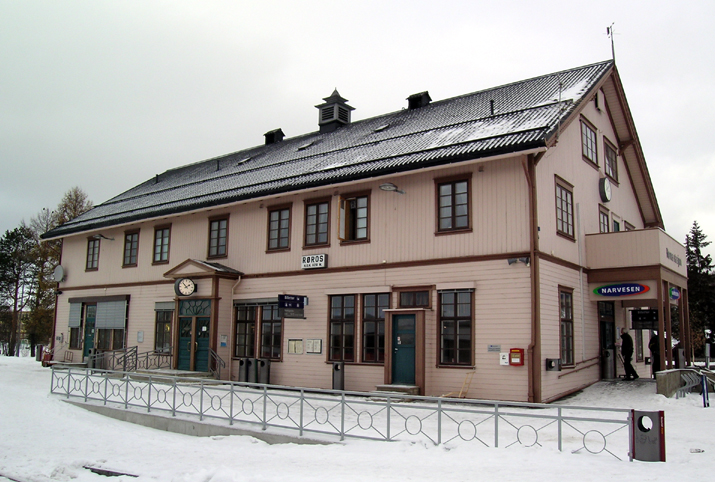- Røros Line
Infobox rail line
name = Røros Line
nativename = Rørosbanen
caption =Røros Station atRøros
type =Railway
system = Norwegian railway
status =
start = Hamar
end = Støren
stations = 28
open = 13 October 1877
close =
owner =Norwegian National Rail Administration
operator =Norges Statsbaner
character = Regional passenger
stock = BM92, BM93
linelength = convert|383|km|mi|0
tracklength =
notrack = 1
gauge = RailGauge|sg
el = No
speed =
elevation = convert|670|m|ft|0|The Røros Line ( _no. Rørosbanen) is a 383 km long
railway line inNorway running between the towns ofHamar andStøren viaElverum andRøros . It connects to theDovre Line at Hamar toOslo and at Støren toTrondheim . Thenarrow gauge line was opened in 1877, running between Hamar and Trondheim, a total of 431 km. With the opening of the Dovre Line in 1921, the northern section from Støren to Trondheim became a part of this line. The line is owned by theNorwegian National Rail Administration .Route
The Røros Line follows the
Østerdal valley, running alongside the River Glomma for much of the way. In terms of the Norwegian railway system the Røros Line is a secondary route between Oslo and Trondheim, the primary route between those two places being by way of the Dovre Line.As well as being connected to the Dovre Line, the line also has connections to the
Meråker Line (at Trondheim) and theSolør Line (at Elverum). The summit of the line, at Harborg, is 670 metres above sea level—a fairly low elevation for a Norwegian main line. The Røros Line is Norway's second longest stretch of unelectrified railway, the longest being theNordland Line .Today, passenger trains on the Røros Line are operated exclusively by small
diesel multiple units of the types BM92 and BM93 operated byNorges Statsbaner .History
Rørosbanen was built between 1862 and 1877. The first part, between Hamar and Elverum (Grundset) opened as the
Hamar–Grundset Line (38 km) in 1862, and was later extended to Rena (Aamot) as "Aamotbanen" (26 km) in 1871. The northern part was opened asTrondhjem–Støren Line (49 km) in 1864. The Røros Line itself was built in sections from north and south, Rena–Koppang (56 km) opened in 1875, Støren–Singsås (30 km) in 1876, Singsås–Røros (79 km), and Røros–Koppang (153 km) in 1877.On 14 August 1877 the lines from south and north was connected at the farm Skjøten in
Alvdal , and the official opening of Rørosbanen took place at Røros on 13 October 1877. The route is Norway's oldest mainline railway, defined as one connecting two regions of the country: in this instance eastern and central Norway. The connection southwards from Hamar was with boat over the lakeMjøsa to Eidsvoll, and theHoved Line to Oslo (Kristiania). The railway connection between Eidsvoll and Hamar opened as Eidsvold–Hamar Line in 1880.Gauge
At the time of the construction of Rørosbanen, there was a gauge controversy in Norway. While the
Hoved Line already in 1854 had been built withstandard gauge , it was argued, notably by railway director Carl A. Pihl, that narrow gauge was more suitable for Norwegianlandscape and also less expensive. Unfortunately, this became the choice for the Røros Line, and all other lines constructed in Norway in years to come, unless they connected to the Swedish railways.The extension of
Hoved Line to Hamar (1880) was built with standard gauge and caused an inconvenientbreak-of-gauge for transport at the Røros Line, and a change to standard gauge was debated repeatedly, however without any decision made. For the opening of the Dovre Line in 1921, the Støren to Trondheim section was transferred to standard gauge, leaving the Røros Line with break-of-gauges at both terminals, and eventually it was decided to convert the line as well. The Hamar to Koppang line was ready in 1931, but it would take another 10 years until the Koppang to Støren line was converted by the Germans during the war in1941 .Åsta Accident
The
Åsta accident occurred on 4 January 2000, a northbound Type 92 multiple unit and a southbound passenger train headed by a Di 3 locomotive collided on the line nearÅsta Station , killing 19 people. The accident caused a temporary closure of the route while the line's safety was investigated. The Røros Line being a non-electrified line, the method of cutting the power to trains seen to be on a collision course was not available. Furthermore, the line was not equipped withAutomatic Train Control . When the train traffic controller became aware that the trains involved were heading for a collision he tried to send a warning to the train drivers bymobile phone , but the phone numbers were either wrong or did not work. There was controversy in the aftermath about whether the driver of the northbound train had ignored or overlooked a red danger signal or whether the signal system itself was faulty. [ [http://catless.ncl.ac.uk/Risks/21.28.html#subj1 Risks Digest Vol 21] ]Future developments
The Røros Line competes for traffic with a main road through the Østerdal and some people have called for the permanent closure of the line to save money, arguing that trucks and buses can handle the extra traffic if the line is closed. Other people have opposed such a closure. [cite web| url=http://www.ostlendingen.no/apps/pbcs.dll/artikkel?Dato=20011123&Kategori=ONYHETER&Lopenr=111231024&Ref=AR| title=Rørosbanen vital for us |language=Norwegian |author=Østlendingen |date=2005-11-23]
There are plans for a completely new high speed railway net in Norway. In 2007, a German university suggested that the high speed Oslo–Trondheim railway should follow the Røros Line route. This would be cheaper, as cities along the present main
Dovre Line are rather small. SeeHigh-speed rail in Norway .Photographs
References
External links
* [http://www.jernbaneverket.no/jernbanenettet/stasjonssok/stasjonsoversikt/Rorosbanen/ Station list at the Norwegian National Rail Administration] no icon
Wikimedia Foundation. 2010.
